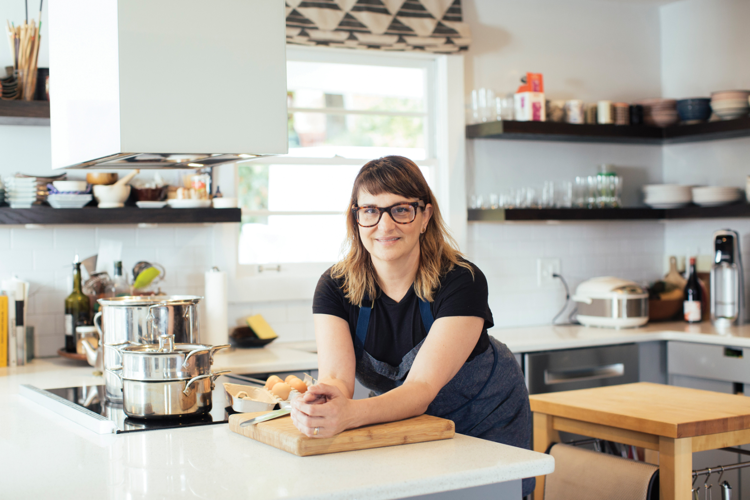
Sarah Gavigan
To paraphrase Barbara Mandrell, Sarah Gavigan was otaku when otaku wasn’t cool. “Otaku literally means ‘at home,’ like a person who stays home all the time and just plays video games,” she says. “It’s come to mean a deep, deep obsession.” Gavigan declared her own infatuation with ramen, the traditional broth-and-noodle dish that is an integral part of Japanese food culture, by giving her first pop-up cooking events the name Otaku South. Now with her first book, Ramen Otaku: Mastering Ramen at Home, she tells the story of her path to otaku and shares the techniques and recipes she now employs in the kitchen at her popular noodle shop in the Gulch, Otaku Ramen.

In the mysterious world of ramen cooking, where knowledge is often begrudgingly passed on from chef to apprentice, this sort of sharing is very rare. “As far as I know, we’re the first ramen shop to publish our recipes straight from the recipe book at the restaurant,” says Gavigan.
The book, co-written with Ann Volkwein, is not a broad survey of ramen — it’s the story of Gavigan’s own compulsive search to create something that is faithful to the Japanese traditions of the dishes while at the same time explaining her own unique take on ramen cookery. “This is not casual cooking,” she says. “It’s sport cooking, for the sort of people who spend all weekend working on complicated dishes or smoking meat outside overnight.”
While the recipes are converted for use in the home kitchen, with ingredient quantities reduced to nonindustrial portions and directions for both stovetop and pressure-cooker use (for all you Instant Pot devotees out there), the fact, is ramen is generally created only in restaurant kitchens.
“They don’t really do ramen at home in Japan,” says Gavigan. “There’s a lot of risk in the book to give people permission to do it at home, but I started at home, and I made it at home. There’s a whole new generation of people doing these kind of things. I have been surprised to see how many otaku people there are in this area, people dedicated to the curiosity of discovering everything about this food.”

Tantan MazemanPhoto: Emily Dorio
After 20 years in L.A. working in film and music production, Gavigan returned to her Middle Tennessee birthplace and has spent most of the past decade studying ramen and learning about the restaurant business. She opened Otaku Ramen and two other culinary projects, POP Nashville on the East Side, and the more bistro-style Little Octopus, around the corner from her ramen shop in the Gulch. “I think it’s crazy that I’m literally learning to be a chef while running my restaurants,” she admits. Fortunately, she hires well. “It’s all about the team, anyway. I learn from who I work with every day.”
Still, there’s always the specter of self-doubt. “I’m continually insecure about my reputation as a chef, but I am a chef. I cook food. I write recipes. I create dishes.” Even so, she explains, writing her first book was, surprisingly, easier for her. “In the music business, they say you have your whole life to write your first record. This came out naturally. It was fun to do, because it felt impossible. Normally the secrets of ramen are proprietary to each master, but it’s not complicated: It’s bones and water and noodles. I say, ‘It’s simple, but it’s not easy.’ ”
Indeed, the recipes and preparations in Ramen Otaku are not simple, with some broths that take a whole day to cook, and exotic soup toppings that require an extra day to cure or ferment before you even start thinking about adding them to a bowl of ramen. But it you’re a fan of eats of the Alton Brown Good Eats or J. Kenji López-Alt Serious Eats varieties, this cookbook should be right up your alley. Recipes are extensively researched and clearly explained with gorgeous photographs to illustrate ingredients and techniques.“The food styling was the easy part,” says Gavigan with a chuckle, “because we have to make every bowl look this pretty at the restaurant, anyway.”

Shoyu RamenPhoto: Emily B. Hall
Gavigan offers advice on what ingredients are better to purchase rather than make at home and where to buy them. Ramen noodles themselves are definitely best sourced via retailers, because the unique alkaline noodles that give ramen its unmistakable “snap” and absorb the broth as they cook in the bowl are simply too complicated to make at home. The book is organized into sections describing how to create various beef, chicken, pork and vegetable stocks and how to match noodles with each one, plus deeply flavored seasonings known as tares and various toppings. By the time readers get to the actual recipes for ramen dishes, it’s basically assembling the already-prepared ingredients into beautiful bowls.
While the casual reader might balk at all the work required to build a proper bowl, Gavigan emphasizes that these ingredients and techniques can be used for many other purposes in the home kitchen. “I want people to use these recipes and then not use them — to riff off them. These ingredients are so versatile. The one thing I want people to know is that almost anything made elementally can be used for something else.”
She offers as an example her recipe for Koji Chicken Breast, flavored with a mixture of fermented rice and salt that is the secret weapon in many Japanese recipes as a source of umami, the mystical savory taste that is important in every cuisine. In the book, Gavigan sincerely boasts: “This recipe is going to change your life as a cook. I am not being dramatic. Game changer. It’s dead simple and the payoff is great.”
In fact, the search for umami — the Japanese term for the savory fifth taste, the companion to sweet, salty, sour and bitter — is the organizing principle of the entire book. “It’s all about umami,” says Gavigan. “It’s an emotion. It lights up parts of the brain that nothing else does. I started out writing a book about ramen and ended up writing a book about umami.”
Although most diners associate umami with monosodium glutamate or, say, Parmesan cheese, Gavigan discovered that it’s much more complicated than that, but simple at the same time. “I didn’t realize that umami is actually science. Once you learn that it comes from specific amino acids, you can learn how to use them to make different combinations.” A fascinating umami chart in the book demonstrates which foods contribute elements of flavor through compounds like glutamine, inosetic acid and guanylic acid, and how they come together in a great bowl of tonkotsu ramen.
On Tuesday, Nov. 13, Gavigan will celebrate her book’s release with an event at Otaku Ramen. Tickets for the event are $50 and include an autographed copy of the book, one limited-edition poster featuring artwork from the book, ramen “shooters” highlighting brand-new recipes, and Sapporo beer.
As geeky as Ramen Otaku gets at times, it’s a pleasing read, following one chef’s journey into her personal food obsessions. And along the way, Gavigan learns a delightful truth. “I didn’t expect the simple amount of joy that the ramen shop gives people,” she says. “My job is to make people happy with food. A good bowl of ramen and 15 minutes of contentment is a great thing I can give to people. This cookbook has allowed me to extend my reach with that. I hope this helps people connect even more with what we’re doing.”








